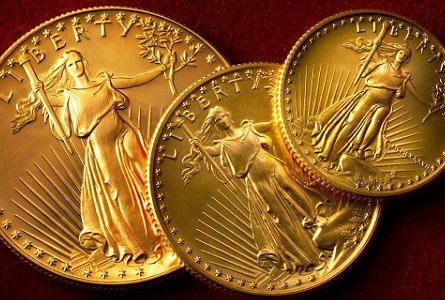by Louis Golino for CoinWeek
There is no question that the policies of the U.S. Federal Reserve Bank, specifically its role in shaping monetary policy, have a big impact on precious metal markets.
The Fed sets short-term interest rates, whereas long-term rates are pegged to the 10-year Treasury bond, which is a function of how much premium bond buyers demand for investing in a supposedly safe government asset instead of riskier ones.
Since the start of the financial crisis in 2008, however, the Fed’s actions, meetings, and words have had an unusually large impact on precious metal prices.
Those markets seem to hang on every word that Chairman Ben Bernanke utters, and every interview or statement on interest rates or the economy that a Fed governor gives. It’s as if Bernanke were the Oracle of Delphi.
 But we may have reached the point where markets and market watchers, especially those interested in precious metals, have become too obsessed with the prospects for more quantitative easing, or QE. It is widely believed that QE will produce future inflation on a major scale, which is seen as good for gold in particular because it is traditionally viewed as a hedge against inflation.
But we may have reached the point where markets and market watchers, especially those interested in precious metals, have become too obsessed with the prospects for more quantitative easing, or QE. It is widely believed that QE will produce future inflation on a major scale, which is seen as good for gold in particular because it is traditionally viewed as a hedge against inflation.
QE has become almost a fetish for gold watchers and market analysts. This perspective was on full view on April 25 during the Fed’s monthly meeting that is closely watched by economists and finance experts.
There are several problems with seeing QE as the be all and end all for metal prices.
First of all, markets are not very good at digesting Fed meeting minutes and the utterances of Bernanke quickly. They tend to react at first in an almost mechanical way, but then after people have a time to think about what has happened, they often react differently.
This happened on April 25 when gold and silver quickly sold-off because the Fed made clear there will be no more QE in the short-term. But then prices rebounded just as quickly when it sank in that one of the main points made that day is that interest rates will stay low for an extended period, and specifically though the end of 2014, if not later, depending on economic conditions.
Second, many people think that QE 3 of one sort or another will take place after the election, but we should take the Fed at its word that the prospects for QE will actually turn on economic events and conditions in the U.S. and to a lesser extent on what happens in Europe, not on political calculations, which are not the Fed’s purview.
Besides, the Fed has come under a lot of criticism for so-called “money printing,” and if it were to do so without economic justification, there would be a huge outcry. Remember what was said during the Republican primary, especially by Texas Governor Rick Perry, who almost accused Bernanke of treason (except that he could not pronounce the word).
Third, too much focus on QE ignores not just long-term fundamentals like supply and demand but the whole panoply of factors that shape metal prices.
Moreover, there are many reasons why spot gold rebounded back towards the $1650 level within hours of the otherwise disappointing Fed statements on April 25 and headed higher the next day.
It is therefore useful to review the factors that would seem to support higher, or at least stable precious metal prices, and those which point in the other direction. It should also be remembered that prices for silver, platinum, and palladium, the white metals, will turn in large part on economic conditions since they all have industrial applications.
But in terms of gold, a lot of bullish trends and signals are emerging whatever the prospects in the short-term for QE.
An important consideration in this regard is the metal prices are not shaped only by developments in the U.S. There are global forces at work too.
One of the main ones is that the IMF has just announced that 12 central banks around the world, led by Mexico, increased their gold reserve holdings in March.
The largest purchases were made by Mexico, Turkey, and Russia. In addition, it is believed that China also added considerably to its holdings, but it does not report its gold purchases, and information about them often only seeps out years after the fact. In fact, China is not the only country that is coy about its gold reserves, as other countries also frequently purchase more than they report publicly.
Analysts such as Jeffrey Nichols (www.nicholsongold.com) explain that these central bank gold buys help provide downside protection for the price of gold “with central banks buying on dips when their purchases would not be disruptive or particularly visible to other market participants and observers of the gold scene.”
Another bullish sign is the fact that in countries in the Middle East and elsewhere that are experiencing great turmoil, such as Iran, Syria, or Greece, those who have financial assets are looking for liquid and portable ways to move their wealth out of the country and protect against currency depreciation, so they are buying a lot of gold, often paying high premiums.
In Iran, for example, gold buyers recently ordered several hundred thousand gold coins, but the Iranian bank said it could only deliver about half the coins, and that the rest would be payable with paper certificates of deposit.
Second, although demand for gold from China has declined due to the slowing economy there, the Hindu Indian gold buying season has just gotten off to a solid start, which should support higher prices, and I expect the Chinese lull to be temporary. The World Gold Council (www.gold.org) recently said that China is poised to overtake India this year as the world’s largest gold market.
Third, I would not worry so much about QE and would pay more attention to interest rates. Rates are more than likely staying low for the next couple years, despite the rumblings one hears about the possibility of raising them sooner than later because of improvements in economic conditions.
Finally, the whole obsession with QE may be a bit misplaced. Bernanke has stated publicy that he opposes efforts to create more inflation, or to inflate our way out of our predicament. One could argue that his actions will still create inflation anyway, but so far that has not happened as all the excess liquidity the Fed has created has stayed on bank balance sheets and in the accounts of very wealthy people.
On the potential downside, I think a deterioration of the European financial crisis as began to occur in recent weeks is a major consideration, especially with Spain once again having trouble raising the funds it needs from the bond market and the fall of the Dutch government last week.
There are also growing concerns about France, specifically, that either a government led by Socialist Francois Hollande, or even a reelected Sarkozy, may move away from commitments agreed at the EU level to deal with the crisis, and that new tension could emerge in the Franco-German relationship that would be bad for resolving the crisis.
Such developments tend to be bullish for the dollar and generally bad for gold, but they are also not preordained.
And if the economy were to steadily continue to improve, unlikely as that may seem, metals would most likely slide backwards probably towards the $1500 level or so.
I do think we will eventually see both higher inflation and higher interest rates, but it may take longer than many people expect. Besides, gold is much more than a hedge against inflation. It is a form of currency and a hedge against economic uncertainty, both of which remain useful.
 Louis Golino is a coin collector and numismatic writer, whose articles on coins have appeared in Coin World, Numismatic News, and a number of different coin web sites. His column for CoinWeek, “The Coin Analyst,” covers U.S. and world coins and precious metals. He collects U.S. and European coins and is a member of the ANA, PCGS, NGC, and CAC. He has also worked for the U.S. Library of Congress and has been a syndicated columnist and news analyst on international affairs for a wide variety of newspapers and web sites.
Louis Golino is a coin collector and numismatic writer, whose articles on coins have appeared in Coin World, Numismatic News, and a number of different coin web sites. His column for CoinWeek, “The Coin Analyst,” covers U.S. and world coins and precious metals. He collects U.S. and European coins and is a member of the ANA, PCGS, NGC, and CAC. He has also worked for the U.S. Library of Congress and has been a syndicated columnist and news analyst on international affairs for a wide variety of newspapers and web sites.





Mr. Golino: Thank you for such a calm and reasoned study of the gold markets. Far too many other comentators are gold bugs or salesmen.
Thanks very much, Mr. Roy. I appreciate your positive feedback.
Louis, I want to thank you as well. This was a very well written article. I look forward to hearing more of your thoughts about the precious metals market and coins.
Being that you are an expert, what do you believe drives numismatic pricing excluding the metal it is pressed in?
Thanks, Francis. It’s basically supply and demand that drives numismatic prices, though specific types of coins and series are driven by various other factors. Keep reading this column for more!
lou,
what do you think drove the numismatic market in the late 80’s to dizzying heights? Gold price rise also speaks of failure of GOVT as it has so many times in the past.Their ability to lead and manage is being called into question. Gold acts as a barometor of fear. Supply & demand also plays a part in USD settlement.
silverbug,
Probably the key factor in the overheated numismatic market of the late 1980’s was the fact that Wall Street coin investment funds were started, which helped drive prices to new highs. But prices rose too far too fast, and it was a classic bubble situation.